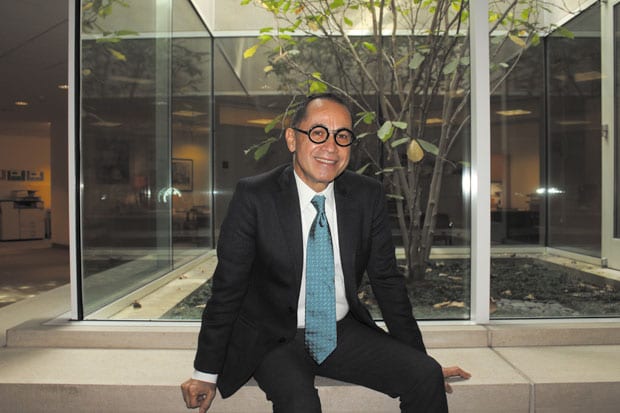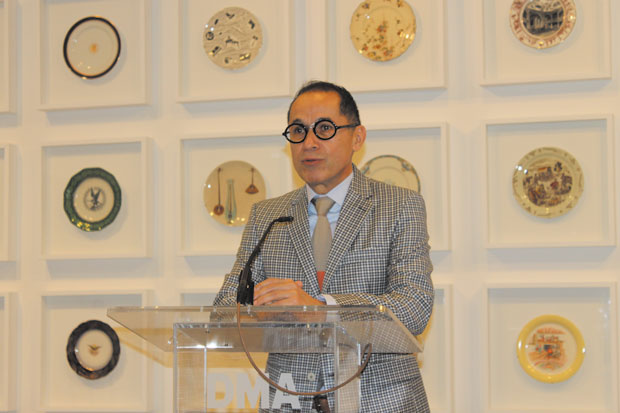The Dallas Museum of Art tapped out art historian Agustin Arteaga as its new artistic director. So what does he have in store for the venerable institution?

Agustin Arteaga inside the offices of the Dallas Museum of Art, where he is now the new executive director. (Arnold Wayne Jones/Dallas Voice)
ARNOLD WAYNE JONES | Executive Editor jones@dallasvoice.com

When Agustin Arteaga begins a new job at a museum, he likes to grab the keys to the storage room and begin rummaging. Many large museums are notorious for having extensive permanent collections, but only sharing a small percentage with the viewing public.
“One of the very first things I did [when I became director of Mexico City’s Museo Nacional de Arte] was to dig into the storage and bring into a temporary exhibit 180 objects, about 60 percent of which had never been shown. Sometimes we lose perspective about what museums are about — we are focused on the new blockbuster and forget we have in our collections extraordinary works. That gives us a chance to look at them anew. Certainly one of the things we will be working on here.”
“Here” refers to his new role as Eugene McDermott executive director of the Dallas Museum of Art. When Maxwell Anderson suddenly departed the post more than a year ago, it triggered a worldwide search. Arteaga was announced last summer, and took over the role with barely a week’s break this past September. Since then, he has been settling in, though his ties to the DMA run deep.
“Texas has been close to my heart in many ways,” says Arteaga over a cup of coffee in his still-sparsely-decorated office. “I have had contact with the museum since the late 1980s and have known all the directors and came here many, many times. Dallas has lots of energy, so it’s great to be here.”
Although he’s only two hours by plane from his prior job in Mexico City, the move is “a big deal in many ways.” Arteaga moved here with his husband, who “has played a big role in my life in supporting me and helping with a very difficult part of the job — the fundraising,” he says. Still, it’s something he has done before (Arteaga has also worked and lived in Argentina, France and Puerto Rico), and the appeal of the position was too much to resist.
“I was excited about the chance of becoming the director here. An institution as prestigious as the DMA would be tempting for any museum professional — not just the [scope] of the collection, but so much more to continue to discover within our own storage rooms. It’s all so vast.”
Exploring the collection, however, is just one prong of Arteaga’s approach to serving the community — a role he takes especial care with.
“An important end is the public,” he says. “One reason why museums exist is to serve their constituents. Last year, the DMA had over 720,000 visitors. The demographics [of the city] are really changing — you can see people from all over the world coming to Dallas. That makes it exciting to serve all kinds of people.”
Another component is “how much society enjoys its cultural institutions — not just the DMA, but the Arts District and all across Dallas-Fort Worth. [It’s great] how much people join together to sustain these institutions. Dallas has strength in opera, theater, museums … those elements are very seldom found in one place,” Arteaga says.
One of the jobs of an executive director, of course, is serving the twin masters of serving the community while being financially responsible. “We have to let people know what a positive impact we have on the city, but on the other end is the challenge to find financial sustainability,” he says. “Museums are balancing acts — how can you give people access to the best examples of 5,000 years of human creation, while being able to sustain that? Because it’s not inexpensive. When an institution proves to be deeply committed to everyone in society, it becomes relevant. That’s what it’s all about — to let people know what happens here will serve all of us and transform the quality of life. Sometimes we don’t talk much about that.”
Arteaga’s thoughtful, holistic ideas about the role of a museum in the life of a city stem from a lifelong commitment to searching out the best that all cultures provide, and bringing together the community to share in our collective human existence.
“We are all different, but all human,” he says. “The DMA is one of the leading institutions in the nation for learning and education — not teaching, but learning. A museum should provide the opportunity for raising questions and challenging visitors, so that they can experience their own desire of discovery. It’s not about enforcing a point of view, not about absolutes and telling people what’s right and wrong but triggering the desire to discover. We are absolutely one of the most democratic spaces that exists in society — we are all safe, we are all welcome, no matter where we come from.”
Arteaga’s humanist philosophy is reflected in his dedication to expanding the horizons of the community by challenging himself as well.
“I love contemporary art because it’s extremely challenging, even for me,” he says. “Sometimes I see things that I really have to dig into to get it and experience the message of what’s going on with that. It’s important to remember [that contemporary art] is the art of our times, and someone reflecting the world we live in. At the same time, I’ve been trained in Western traditions, so I am comfortable within that, but when I see art from Africa or Asia, I can recognize there’s much more behind them. I always tell people that, when I am trying to talk about a world of art, we have to take a distance from the world we live in, and remove ourselves to the world where it was done — not our 21st century, occidental perspective. In that way, you can travel the world without leaving your city.”
Dallas Museum of Art, 1717 Harwood St. Free general admission. DMA.org.
This article appeared in the Dallas Voice print edition December 02, 2016.



